Business Economics: Analysis of UK Economy and Co-op Food
VerifiedAdded on 2020/06/05
|15
|4256
|66
Report
AI Summary
This report provides a comprehensive analysis of the UK economy and its implications for businesses, using Co-op Food as a case study. It begins with an overview of the UK's economic system, characteristics, and the challenges faced by Co-op Food. The report delves into key economic concepts such as scarcity, supply, demand, market systems (perfect competition, monopoly, oligopoly), opportunity costs, and elasticity of demand, explaining their significance in the context of the UK economy. It further explores pricing strategies, market structures, and the impact of UK regulations on market power. The analysis extends to the evolving economic structure of the UK, macroeconomic policy tools, and the evaluation of economic performance using GDP growth, inflation, and unemployment indicators. The report also examines the theory of comparative advantage with reference to emerging economies and their impact on the UK. The report concludes by summarizing the key findings and implications for Co-op Food and other businesses operating within the UK economic landscape.
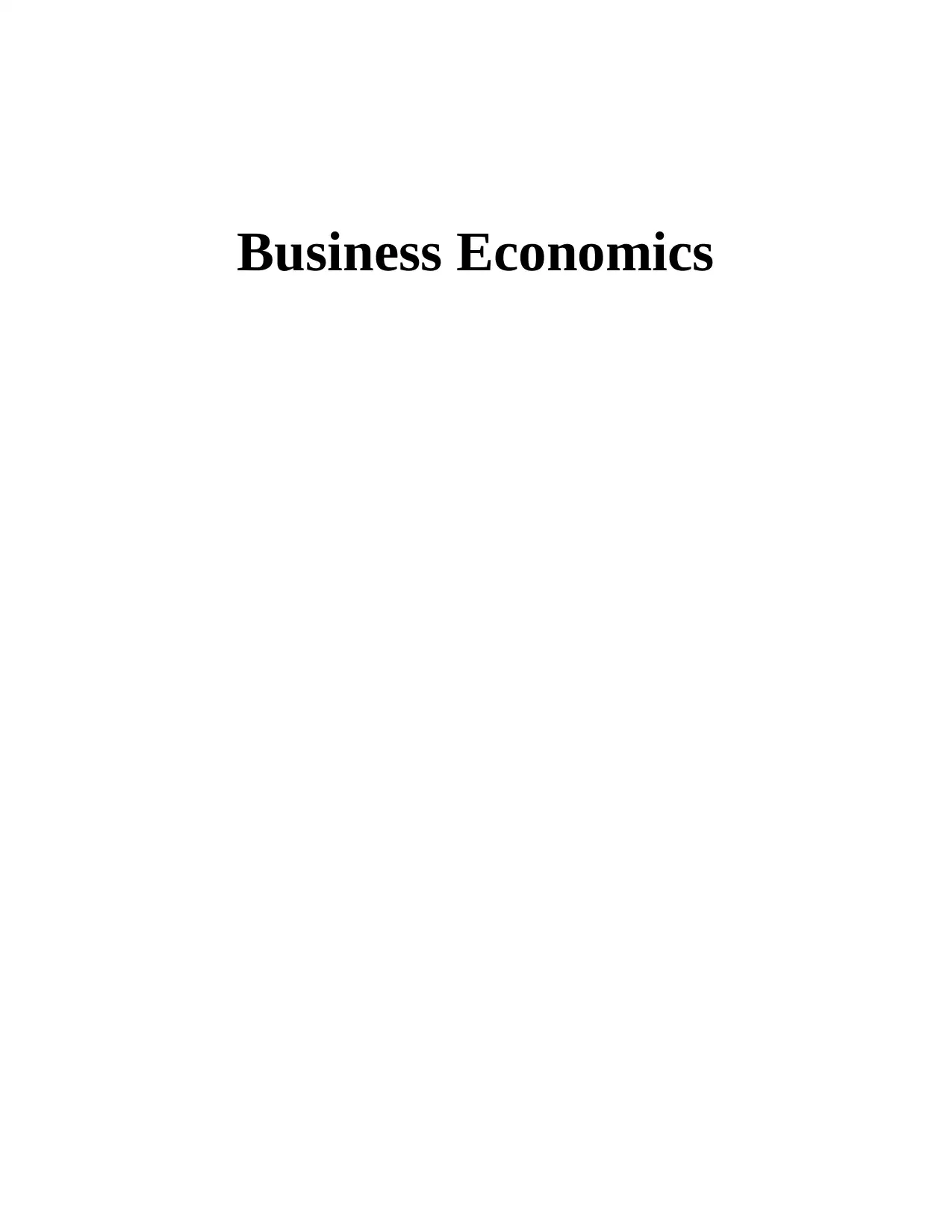
Business Economics
Paraphrase This Document
Need a fresh take? Get an instant paraphrase of this document with our AI Paraphraser
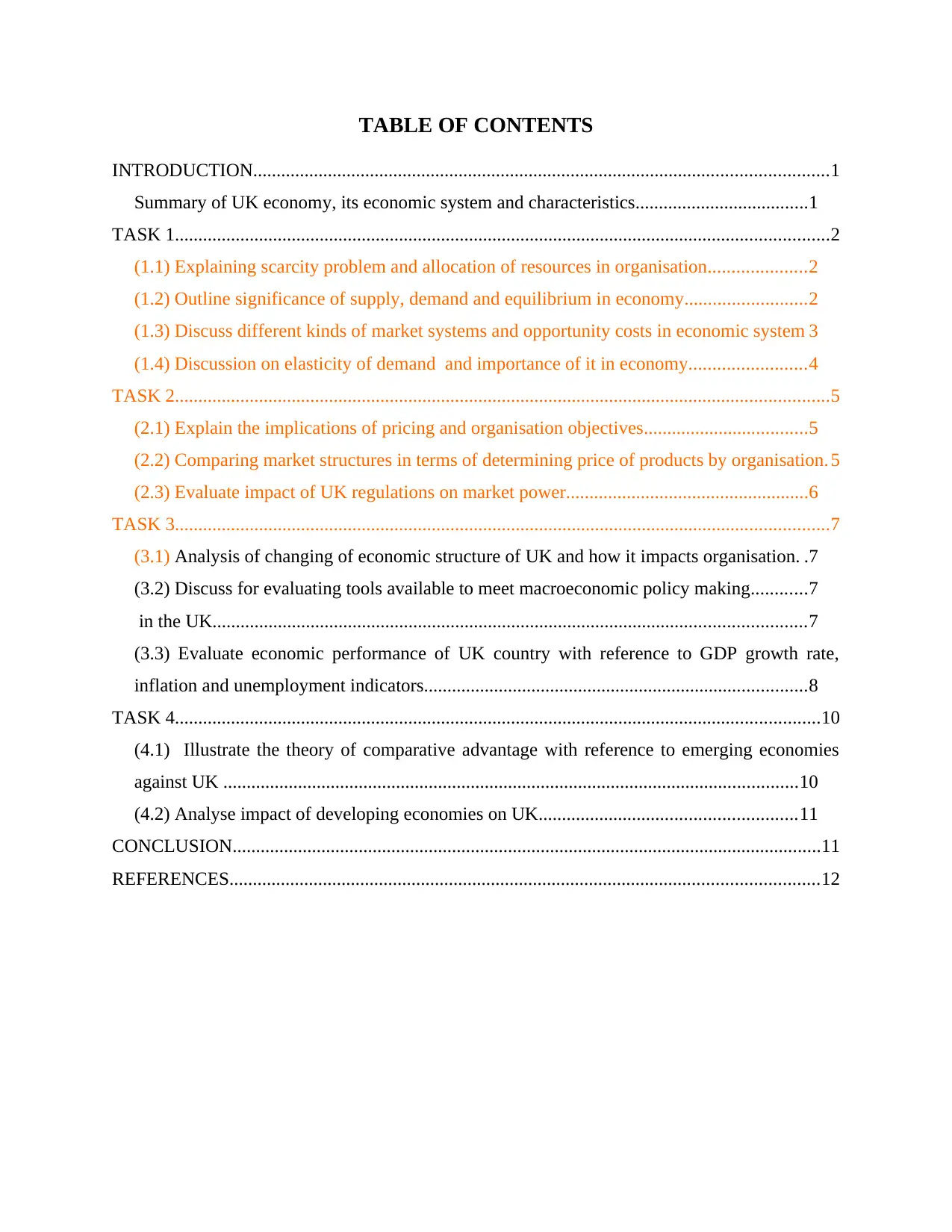
TABLE OF CONTENTS
INTRODUCTION...........................................................................................................................1
Summary of UK economy, its economic system and characteristics.....................................1
TASK 1............................................................................................................................................2
(1.1) Explaining scarcity problem and allocation of resources in organisation.....................2
(1.2) Outline significance of supply, demand and equilibrium in economy..........................2
(1.3) Discuss different kinds of market systems and opportunity costs in economic system 3
(1.4) Discussion on elasticity of demand and importance of it in economy.........................4
TASK 2............................................................................................................................................5
(2.1) Explain the implications of pricing and organisation objectives...................................5
(2.2) Comparing market structures in terms of determining price of products by organisation. 5
(2.3) Evaluate impact of UK regulations on market power....................................................6
TASK 3............................................................................................................................................7
(3.1) Analysis of changing of economic structure of UK and how it impacts organisation. .7
(3.2) Discuss for evaluating tools available to meet macroeconomic policy making............7
in the UK...............................................................................................................................7
(3.3) Evaluate economic performance of UK country with reference to GDP growth rate,
inflation and unemployment indicators..................................................................................8
TASK 4..........................................................................................................................................10
(4.1) Illustrate the theory of comparative advantage with reference to emerging economies
against UK ...........................................................................................................................10
(4.2) Analyse impact of developing economies on UK.......................................................11
CONCLUSION..............................................................................................................................11
REFERENCES..............................................................................................................................12
INTRODUCTION...........................................................................................................................1
Summary of UK economy, its economic system and characteristics.....................................1
TASK 1............................................................................................................................................2
(1.1) Explaining scarcity problem and allocation of resources in organisation.....................2
(1.2) Outline significance of supply, demand and equilibrium in economy..........................2
(1.3) Discuss different kinds of market systems and opportunity costs in economic system 3
(1.4) Discussion on elasticity of demand and importance of it in economy.........................4
TASK 2............................................................................................................................................5
(2.1) Explain the implications of pricing and organisation objectives...................................5
(2.2) Comparing market structures in terms of determining price of products by organisation. 5
(2.3) Evaluate impact of UK regulations on market power....................................................6
TASK 3............................................................................................................................................7
(3.1) Analysis of changing of economic structure of UK and how it impacts organisation. .7
(3.2) Discuss for evaluating tools available to meet macroeconomic policy making............7
in the UK...............................................................................................................................7
(3.3) Evaluate economic performance of UK country with reference to GDP growth rate,
inflation and unemployment indicators..................................................................................8
TASK 4..........................................................................................................................................10
(4.1) Illustrate the theory of comparative advantage with reference to emerging economies
against UK ...........................................................................................................................10
(4.2) Analyse impact of developing economies on UK.......................................................11
CONCLUSION..............................................................................................................................11
REFERENCES..............................................................................................................................12
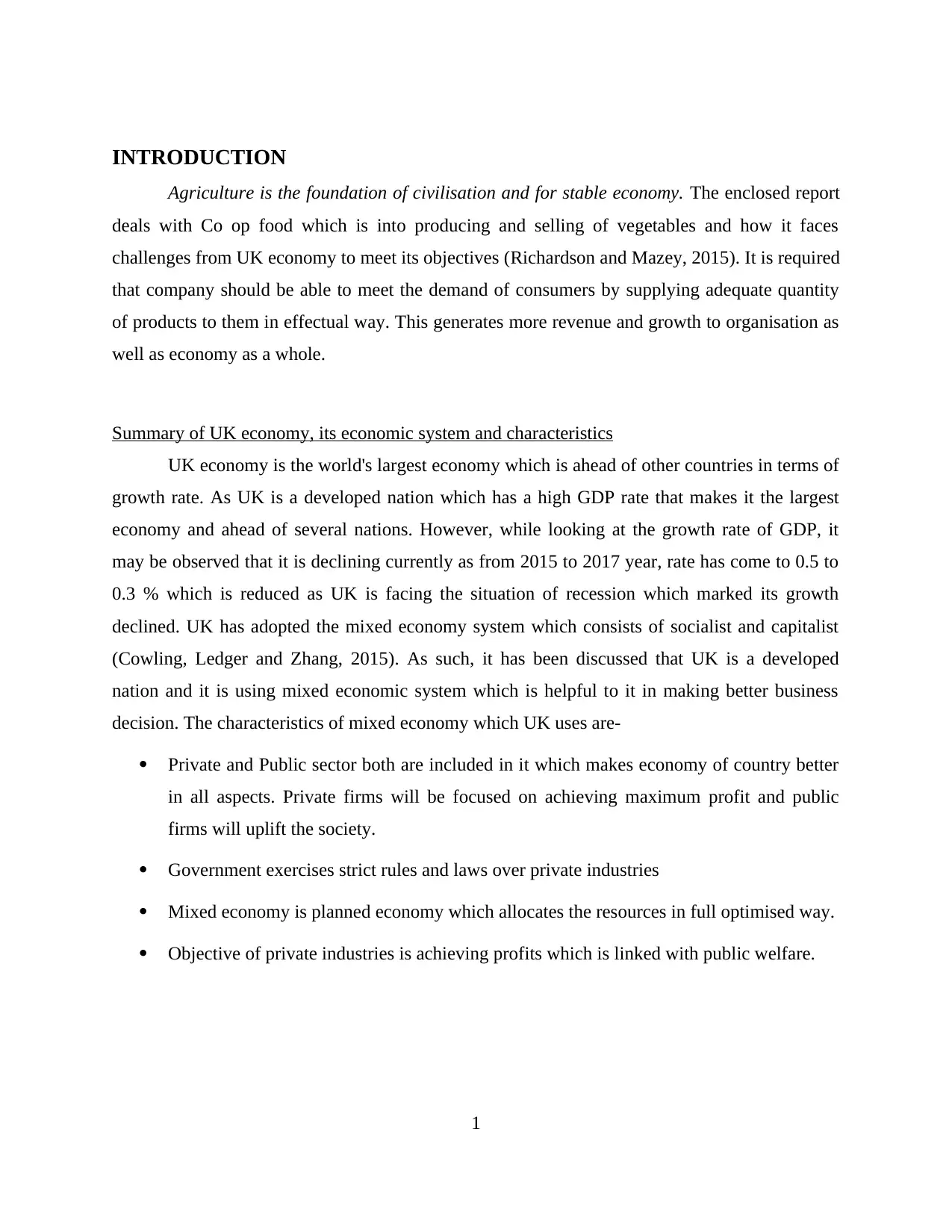
INTRODUCTION
Agriculture is the foundation of civilisation and for stable economy. The enclosed report
deals with Co op food which is into producing and selling of vegetables and how it faces
challenges from UK economy to meet its objectives (Richardson and Mazey, 2015). It is required
that company should be able to meet the demand of consumers by supplying adequate quantity
of products to them in effectual way. This generates more revenue and growth to organisation as
well as economy as a whole.
Summary of UK economy, its economic system and characteristics
UK economy is the world's largest economy which is ahead of other countries in terms of
growth rate. As UK is a developed nation which has a high GDP rate that makes it the largest
economy and ahead of several nations. However, while looking at the growth rate of GDP, it
may be observed that it is declining currently as from 2015 to 2017 year, rate has come to 0.5 to
0.3 % which is reduced as UK is facing the situation of recession which marked its growth
declined. UK has adopted the mixed economy system which consists of socialist and capitalist
(Cowling, Ledger and Zhang, 2015). As such, it has been discussed that UK is a developed
nation and it is using mixed economic system which is helpful to it in making better business
decision. The characteristics of mixed economy which UK uses are-
Private and Public sector both are included in it which makes economy of country better
in all aspects. Private firms will be focused on achieving maximum profit and public
firms will uplift the society.
Government exercises strict rules and laws over private industries
Mixed economy is planned economy which allocates the resources in full optimised way.
Objective of private industries is achieving profits which is linked with public welfare.
1
Agriculture is the foundation of civilisation and for stable economy. The enclosed report
deals with Co op food which is into producing and selling of vegetables and how it faces
challenges from UK economy to meet its objectives (Richardson and Mazey, 2015). It is required
that company should be able to meet the demand of consumers by supplying adequate quantity
of products to them in effectual way. This generates more revenue and growth to organisation as
well as economy as a whole.
Summary of UK economy, its economic system and characteristics
UK economy is the world's largest economy which is ahead of other countries in terms of
growth rate. As UK is a developed nation which has a high GDP rate that makes it the largest
economy and ahead of several nations. However, while looking at the growth rate of GDP, it
may be observed that it is declining currently as from 2015 to 2017 year, rate has come to 0.5 to
0.3 % which is reduced as UK is facing the situation of recession which marked its growth
declined. UK has adopted the mixed economy system which consists of socialist and capitalist
(Cowling, Ledger and Zhang, 2015). As such, it has been discussed that UK is a developed
nation and it is using mixed economic system which is helpful to it in making better business
decision. The characteristics of mixed economy which UK uses are-
Private and Public sector both are included in it which makes economy of country better
in all aspects. Private firms will be focused on achieving maximum profit and public
firms will uplift the society.
Government exercises strict rules and laws over private industries
Mixed economy is planned economy which allocates the resources in full optimised way.
Objective of private industries is achieving profits which is linked with public welfare.
1
⊘ This is a preview!⊘
Do you want full access?
Subscribe today to unlock all pages.

Trusted by 1+ million students worldwide
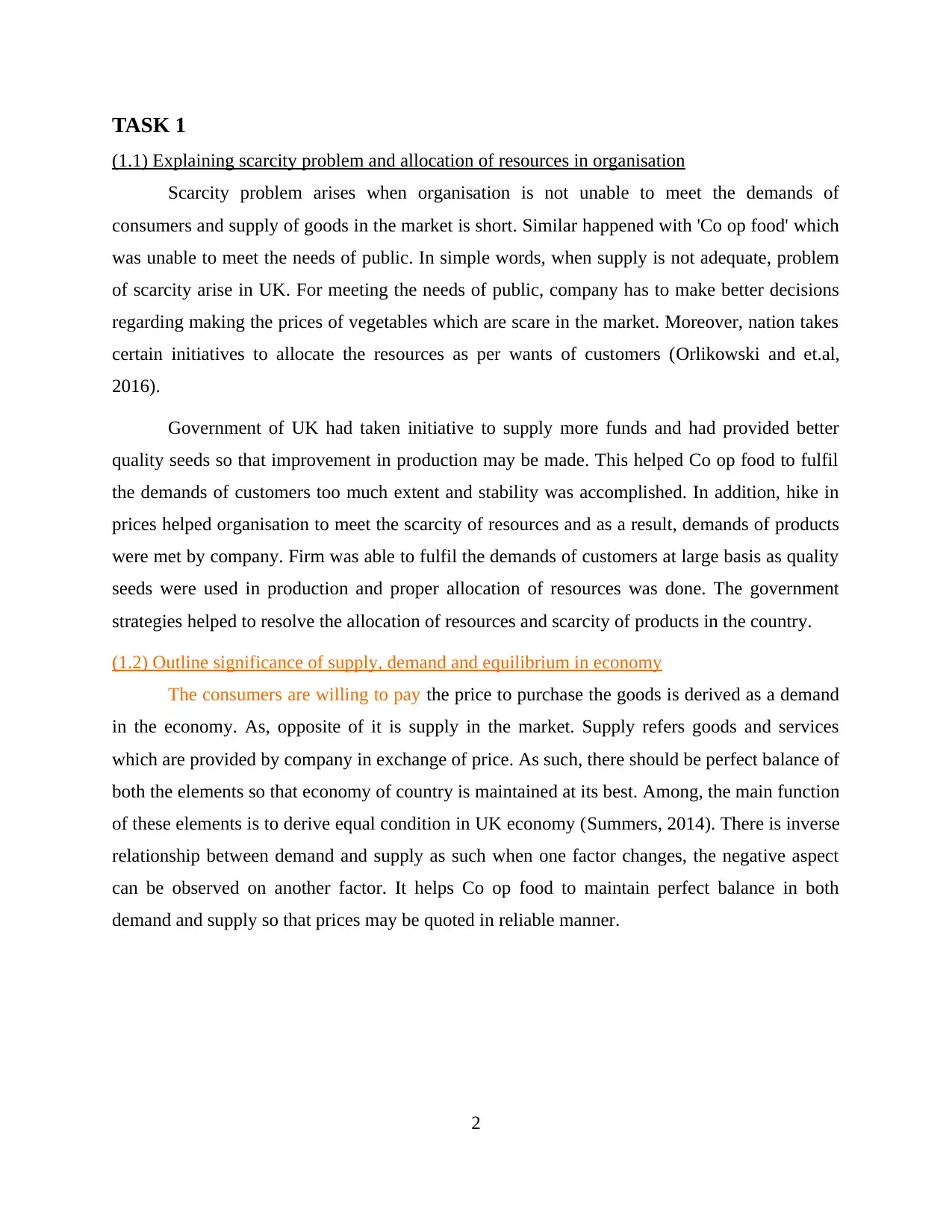
TASK 1
(1.1) Explaining scarcity problem and allocation of resources in organisation
Scarcity problem arises when organisation is not unable to meet the demands of
consumers and supply of goods in the market is short. Similar happened with 'Co op food' which
was unable to meet the needs of public. In simple words, when supply is not adequate, problem
of scarcity arise in UK. For meeting the needs of public, company has to make better decisions
regarding making the prices of vegetables which are scare in the market. Moreover, nation takes
certain initiatives to allocate the resources as per wants of customers (Orlikowski and et.al,
2016).
Government of UK had taken initiative to supply more funds and had provided better
quality seeds so that improvement in production may be made. This helped Co op food to fulfil
the demands of customers too much extent and stability was accomplished. In addition, hike in
prices helped organisation to meet the scarcity of resources and as a result, demands of products
were met by company. Firm was able to fulfil the demands of customers at large basis as quality
seeds were used in production and proper allocation of resources was done. The government
strategies helped to resolve the allocation of resources and scarcity of products in the country.
(1.2) Outline significance of supply, demand and equilibrium in economy
The consumers are willing to pay the price to purchase the goods is derived as a demand
in the economy. As, opposite of it is supply in the market. Supply refers goods and services
which are provided by company in exchange of price. As such, there should be perfect balance of
both the elements so that economy of country is maintained at its best. Among, the main function
of these elements is to derive equal condition in UK economy (Summers, 2014). There is inverse
relationship between demand and supply as such when one factor changes, the negative aspect
can be observed on another factor. It helps Co op food to maintain perfect balance in both
demand and supply so that prices may be quoted in reliable manner.
2
(1.1) Explaining scarcity problem and allocation of resources in organisation
Scarcity problem arises when organisation is not unable to meet the demands of
consumers and supply of goods in the market is short. Similar happened with 'Co op food' which
was unable to meet the needs of public. In simple words, when supply is not adequate, problem
of scarcity arise in UK. For meeting the needs of public, company has to make better decisions
regarding making the prices of vegetables which are scare in the market. Moreover, nation takes
certain initiatives to allocate the resources as per wants of customers (Orlikowski and et.al,
2016).
Government of UK had taken initiative to supply more funds and had provided better
quality seeds so that improvement in production may be made. This helped Co op food to fulfil
the demands of customers too much extent and stability was accomplished. In addition, hike in
prices helped organisation to meet the scarcity of resources and as a result, demands of products
were met by company. Firm was able to fulfil the demands of customers at large basis as quality
seeds were used in production and proper allocation of resources was done. The government
strategies helped to resolve the allocation of resources and scarcity of products in the country.
(1.2) Outline significance of supply, demand and equilibrium in economy
The consumers are willing to pay the price to purchase the goods is derived as a demand
in the economy. As, opposite of it is supply in the market. Supply refers goods and services
which are provided by company in exchange of price. As such, there should be perfect balance of
both the elements so that economy of country is maintained at its best. Among, the main function
of these elements is to derive equal condition in UK economy (Summers, 2014). There is inverse
relationship between demand and supply as such when one factor changes, the negative aspect
can be observed on another factor. It helps Co op food to maintain perfect balance in both
demand and supply so that prices may be quoted in reliable manner.
2
Paraphrase This Document
Need a fresh take? Get an instant paraphrase of this document with our AI Paraphraser
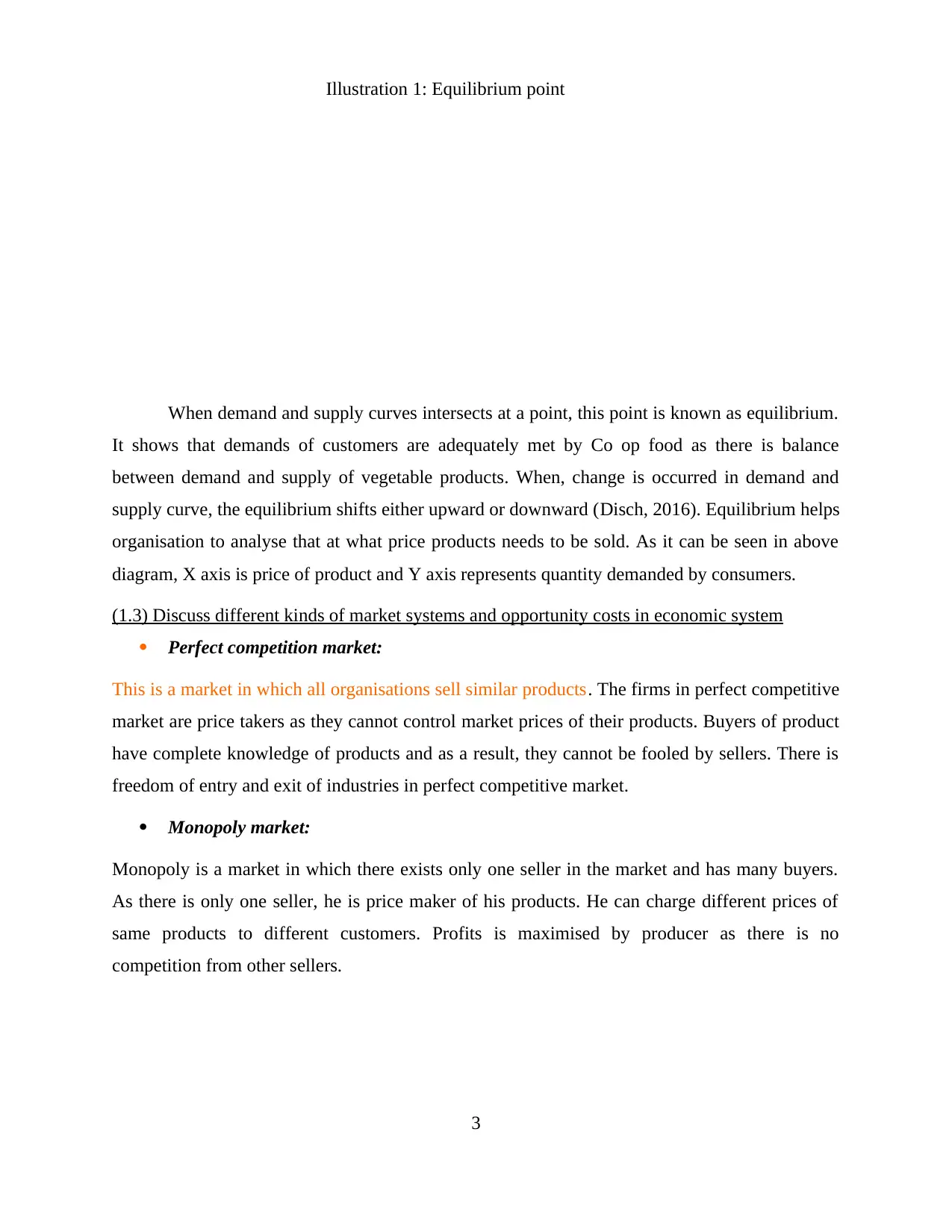
When demand and supply curves intersects at a point, this point is known as equilibrium.
It shows that demands of customers are adequately met by Co op food as there is balance
between demand and supply of vegetable products. When, change is occurred in demand and
supply curve, the equilibrium shifts either upward or downward (Disch, 2016). Equilibrium helps
organisation to analyse that at what price products needs to be sold. As it can be seen in above
diagram, X axis is price of product and Y axis represents quantity demanded by consumers.
(1.3) Discuss different kinds of market systems and opportunity costs in economic system
Perfect competition market:
This is a market in which all organisations sell similar products. The firms in perfect competitive
market are price takers as they cannot control market prices of their products. Buyers of product
have complete knowledge of products and as a result, they cannot be fooled by sellers. There is
freedom of entry and exit of industries in perfect competitive market.
Monopoly market:
Monopoly is a market in which there exists only one seller in the market and has many buyers.
As there is only one seller, he is price maker of his products. He can charge different prices of
same products to different customers. Profits is maximised by producer as there is no
competition from other sellers.
3
Illustration 1: Equilibrium point
It shows that demands of customers are adequately met by Co op food as there is balance
between demand and supply of vegetable products. When, change is occurred in demand and
supply curve, the equilibrium shifts either upward or downward (Disch, 2016). Equilibrium helps
organisation to analyse that at what price products needs to be sold. As it can be seen in above
diagram, X axis is price of product and Y axis represents quantity demanded by consumers.
(1.3) Discuss different kinds of market systems and opportunity costs in economic system
Perfect competition market:
This is a market in which all organisations sell similar products. The firms in perfect competitive
market are price takers as they cannot control market prices of their products. Buyers of product
have complete knowledge of products and as a result, they cannot be fooled by sellers. There is
freedom of entry and exit of industries in perfect competitive market.
Monopoly market:
Monopoly is a market in which there exists only one seller in the market and has many buyers.
As there is only one seller, he is price maker of his products. He can charge different prices of
same products to different customers. Profits is maximised by producer as there is no
competition from other sellers.
3
Illustration 1: Equilibrium point
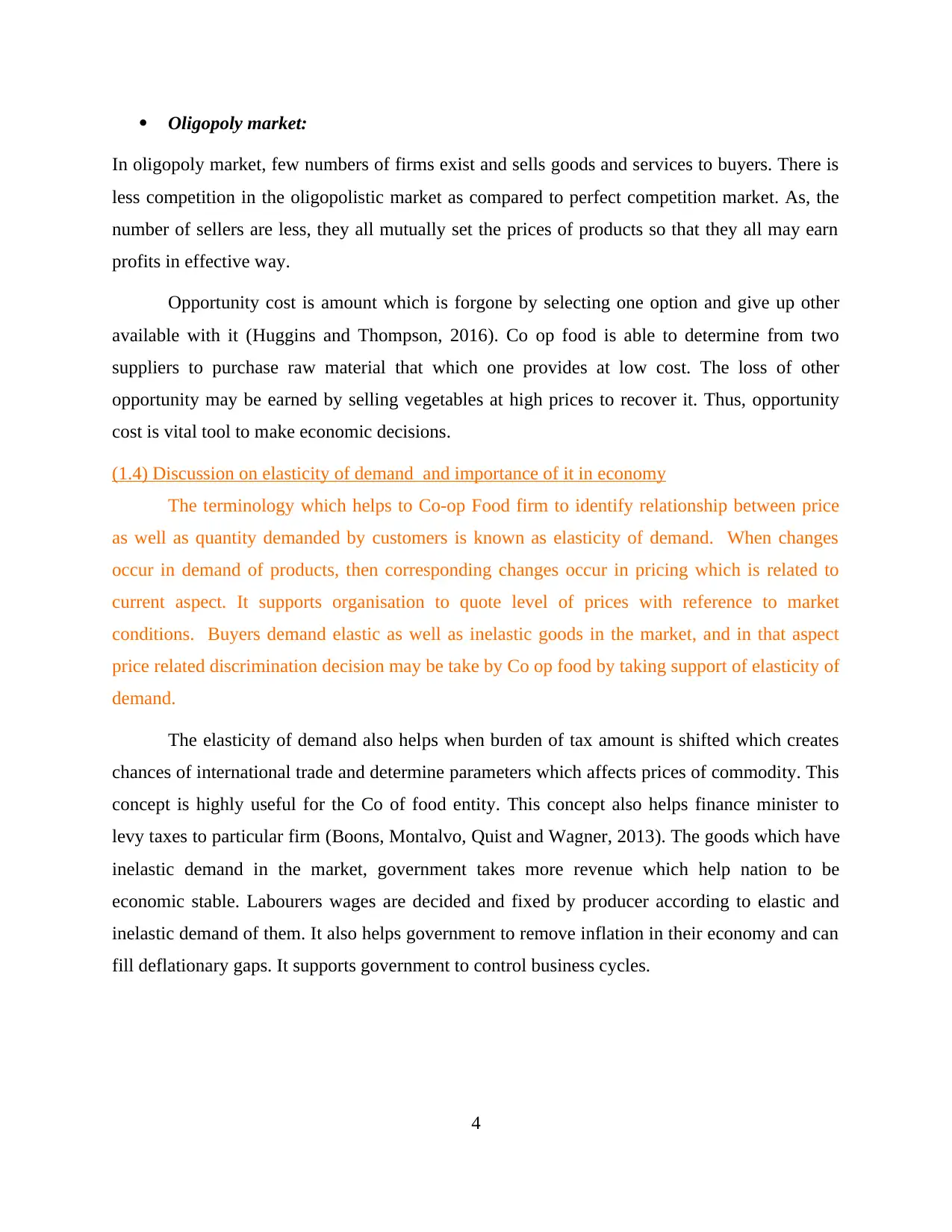
Oligopoly market:
In oligopoly market, few numbers of firms exist and sells goods and services to buyers. There is
less competition in the oligopolistic market as compared to perfect competition market. As, the
number of sellers are less, they all mutually set the prices of products so that they all may earn
profits in effective way.
Opportunity cost is amount which is forgone by selecting one option and give up other
available with it (Huggins and Thompson, 2016). Co op food is able to determine from two
suppliers to purchase raw material that which one provides at low cost. The loss of other
opportunity may be earned by selling vegetables at high prices to recover it. Thus, opportunity
cost is vital tool to make economic decisions.
(1.4) Discussion on elasticity of demand and importance of it in economy
The terminology which helps to Co-op Food firm to identify relationship between price
as well as quantity demanded by customers is known as elasticity of demand. When changes
occur in demand of products, then corresponding changes occur in pricing which is related to
current aspect. It supports organisation to quote level of prices with reference to market
conditions. Buyers demand elastic as well as inelastic goods in the market, and in that aspect
price related discrimination decision may be take by Co op food by taking support of elasticity of
demand.
The elasticity of demand also helps when burden of tax amount is shifted which creates
chances of international trade and determine parameters which affects prices of commodity. This
concept is highly useful for the Co of food entity. This concept also helps finance minister to
levy taxes to particular firm (Boons, Montalvo, Quist and Wagner, 2013). The goods which have
inelastic demand in the market, government takes more revenue which help nation to be
economic stable. Labourers wages are decided and fixed by producer according to elastic and
inelastic demand of them. It also helps government to remove inflation in their economy and can
fill deflationary gaps. It supports government to control business cycles.
4
In oligopoly market, few numbers of firms exist and sells goods and services to buyers. There is
less competition in the oligopolistic market as compared to perfect competition market. As, the
number of sellers are less, they all mutually set the prices of products so that they all may earn
profits in effective way.
Opportunity cost is amount which is forgone by selecting one option and give up other
available with it (Huggins and Thompson, 2016). Co op food is able to determine from two
suppliers to purchase raw material that which one provides at low cost. The loss of other
opportunity may be earned by selling vegetables at high prices to recover it. Thus, opportunity
cost is vital tool to make economic decisions.
(1.4) Discussion on elasticity of demand and importance of it in economy
The terminology which helps to Co-op Food firm to identify relationship between price
as well as quantity demanded by customers is known as elasticity of demand. When changes
occur in demand of products, then corresponding changes occur in pricing which is related to
current aspect. It supports organisation to quote level of prices with reference to market
conditions. Buyers demand elastic as well as inelastic goods in the market, and in that aspect
price related discrimination decision may be take by Co op food by taking support of elasticity of
demand.
The elasticity of demand also helps when burden of tax amount is shifted which creates
chances of international trade and determine parameters which affects prices of commodity. This
concept is highly useful for the Co of food entity. This concept also helps finance minister to
levy taxes to particular firm (Boons, Montalvo, Quist and Wagner, 2013). The goods which have
inelastic demand in the market, government takes more revenue which help nation to be
economic stable. Labourers wages are decided and fixed by producer according to elastic and
inelastic demand of them. It also helps government to remove inflation in their economy and can
fill deflationary gaps. It supports government to control business cycles.
4
⊘ This is a preview!⊘
Do you want full access?
Subscribe today to unlock all pages.

Trusted by 1+ million students worldwide
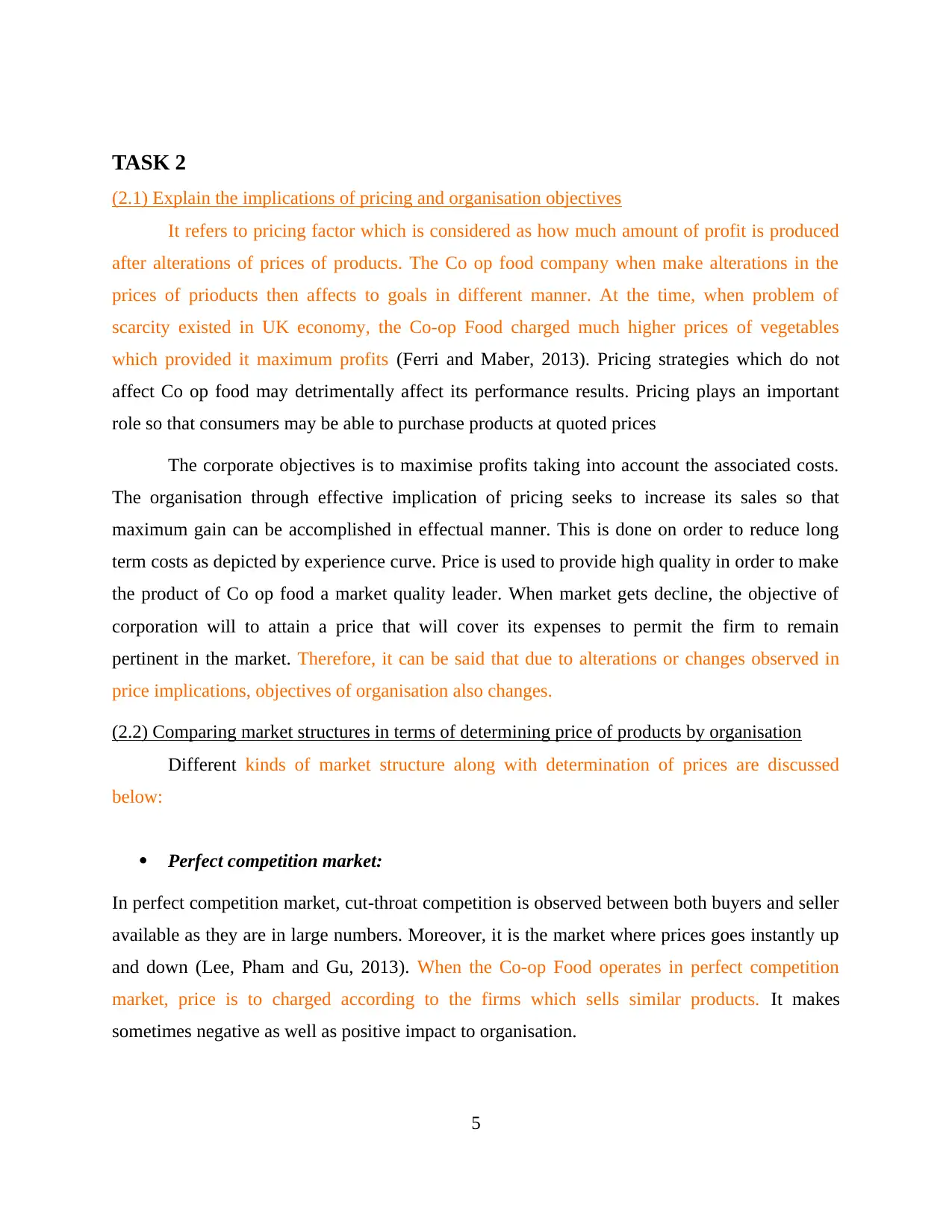
TASK 2
(2.1) Explain the implications of pricing and organisation objectives
It refers to pricing factor which is considered as how much amount of profit is produced
after alterations of prices of products. The Co op food company when make alterations in the
prices of prioducts then affects to goals in different manner. At the time, when problem of
scarcity existed in UK economy, the Co-op Food charged much higher prices of vegetables
which provided it maximum profits (Ferri and Maber, 2013). Pricing strategies which do not
affect Co op food may detrimentally affect its performance results. Pricing plays an important
role so that consumers may be able to purchase products at quoted prices
The corporate objectives is to maximise profits taking into account the associated costs.
The organisation through effective implication of pricing seeks to increase its sales so that
maximum gain can be accomplished in effectual manner. This is done on order to reduce long
term costs as depicted by experience curve. Price is used to provide high quality in order to make
the product of Co op food a market quality leader. When market gets decline, the objective of
corporation will to attain a price that will cover its expenses to permit the firm to remain
pertinent in the market. Therefore, it can be said that due to alterations or changes observed in
price implications, objectives of organisation also changes.
(2.2) Comparing market structures in terms of determining price of products by organisation
Different kinds of market structure along with determination of prices are discussed
below:
Perfect competition market:
In perfect competition market, cut-throat competition is observed between both buyers and seller
available as they are in large numbers. Moreover, it is the market where prices goes instantly up
and down (Lee, Pham and Gu, 2013). When the Co-op Food operates in perfect competition
market, price is to charged according to the firms which sells similar products. It makes
sometimes negative as well as positive impact to organisation.
5
(2.1) Explain the implications of pricing and organisation objectives
It refers to pricing factor which is considered as how much amount of profit is produced
after alterations of prices of products. The Co op food company when make alterations in the
prices of prioducts then affects to goals in different manner. At the time, when problem of
scarcity existed in UK economy, the Co-op Food charged much higher prices of vegetables
which provided it maximum profits (Ferri and Maber, 2013). Pricing strategies which do not
affect Co op food may detrimentally affect its performance results. Pricing plays an important
role so that consumers may be able to purchase products at quoted prices
The corporate objectives is to maximise profits taking into account the associated costs.
The organisation through effective implication of pricing seeks to increase its sales so that
maximum gain can be accomplished in effectual manner. This is done on order to reduce long
term costs as depicted by experience curve. Price is used to provide high quality in order to make
the product of Co op food a market quality leader. When market gets decline, the objective of
corporation will to attain a price that will cover its expenses to permit the firm to remain
pertinent in the market. Therefore, it can be said that due to alterations or changes observed in
price implications, objectives of organisation also changes.
(2.2) Comparing market structures in terms of determining price of products by organisation
Different kinds of market structure along with determination of prices are discussed
below:
Perfect competition market:
In perfect competition market, cut-throat competition is observed between both buyers and seller
available as they are in large numbers. Moreover, it is the market where prices goes instantly up
and down (Lee, Pham and Gu, 2013). When the Co-op Food operates in perfect competition
market, price is to charged according to the firms which sells similar products. It makes
sometimes negative as well as positive impact to organisation.
5
Paraphrase This Document
Need a fresh take? Get an instant paraphrase of this document with our AI Paraphraser
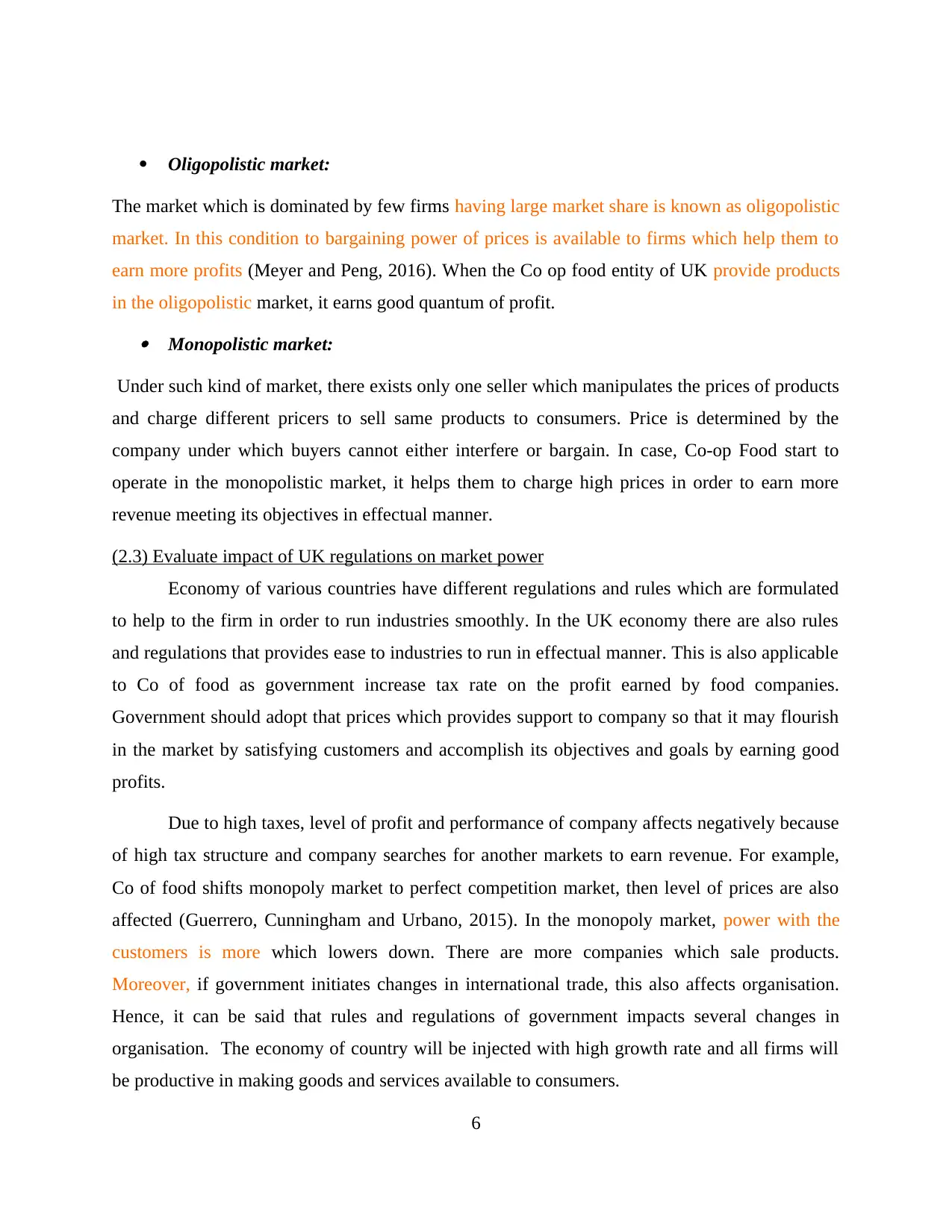
Oligopolistic market:
The market which is dominated by few firms having large market share is known as oligopolistic
market. In this condition to bargaining power of prices is available to firms which help them to
earn more profits (Meyer and Peng, 2016). When the Co op food entity of UK provide products
in the oligopolistic market, it earns good quantum of profit. Monopolistic market:
Under such kind of market, there exists only one seller which manipulates the prices of products
and charge different pricers to sell same products to consumers. Price is determined by the
company under which buyers cannot either interfere or bargain. In case, Co-op Food start to
operate in the monopolistic market, it helps them to charge high prices in order to earn more
revenue meeting its objectives in effectual manner.
(2.3) Evaluate impact of UK regulations on market power
Economy of various countries have different regulations and rules which are formulated
to help to the firm in order to run industries smoothly. In the UK economy there are also rules
and regulations that provides ease to industries to run in effectual manner. This is also applicable
to Co of food as government increase tax rate on the profit earned by food companies.
Government should adopt that prices which provides support to company so that it may flourish
in the market by satisfying customers and accomplish its objectives and goals by earning good
profits.
Due to high taxes, level of profit and performance of company affects negatively because
of high tax structure and company searches for another markets to earn revenue. For example,
Co of food shifts monopoly market to perfect competition market, then level of prices are also
affected (Guerrero, Cunningham and Urbano, 2015). In the monopoly market, power with the
customers is more which lowers down. There are more companies which sale products.
Moreover, if government initiates changes in international trade, this also affects organisation.
Hence, it can be said that rules and regulations of government impacts several changes in
organisation. The economy of country will be injected with high growth rate and all firms will
be productive in making goods and services available to consumers.
6
The market which is dominated by few firms having large market share is known as oligopolistic
market. In this condition to bargaining power of prices is available to firms which help them to
earn more profits (Meyer and Peng, 2016). When the Co op food entity of UK provide products
in the oligopolistic market, it earns good quantum of profit. Monopolistic market:
Under such kind of market, there exists only one seller which manipulates the prices of products
and charge different pricers to sell same products to consumers. Price is determined by the
company under which buyers cannot either interfere or bargain. In case, Co-op Food start to
operate in the monopolistic market, it helps them to charge high prices in order to earn more
revenue meeting its objectives in effectual manner.
(2.3) Evaluate impact of UK regulations on market power
Economy of various countries have different regulations and rules which are formulated
to help to the firm in order to run industries smoothly. In the UK economy there are also rules
and regulations that provides ease to industries to run in effectual manner. This is also applicable
to Co of food as government increase tax rate on the profit earned by food companies.
Government should adopt that prices which provides support to company so that it may flourish
in the market by satisfying customers and accomplish its objectives and goals by earning good
profits.
Due to high taxes, level of profit and performance of company affects negatively because
of high tax structure and company searches for another markets to earn revenue. For example,
Co of food shifts monopoly market to perfect competition market, then level of prices are also
affected (Guerrero, Cunningham and Urbano, 2015). In the monopoly market, power with the
customers is more which lowers down. There are more companies which sale products.
Moreover, if government initiates changes in international trade, this also affects organisation.
Hence, it can be said that rules and regulations of government impacts several changes in
organisation. The economy of country will be injected with high growth rate and all firms will
be productive in making goods and services available to consumers.
6
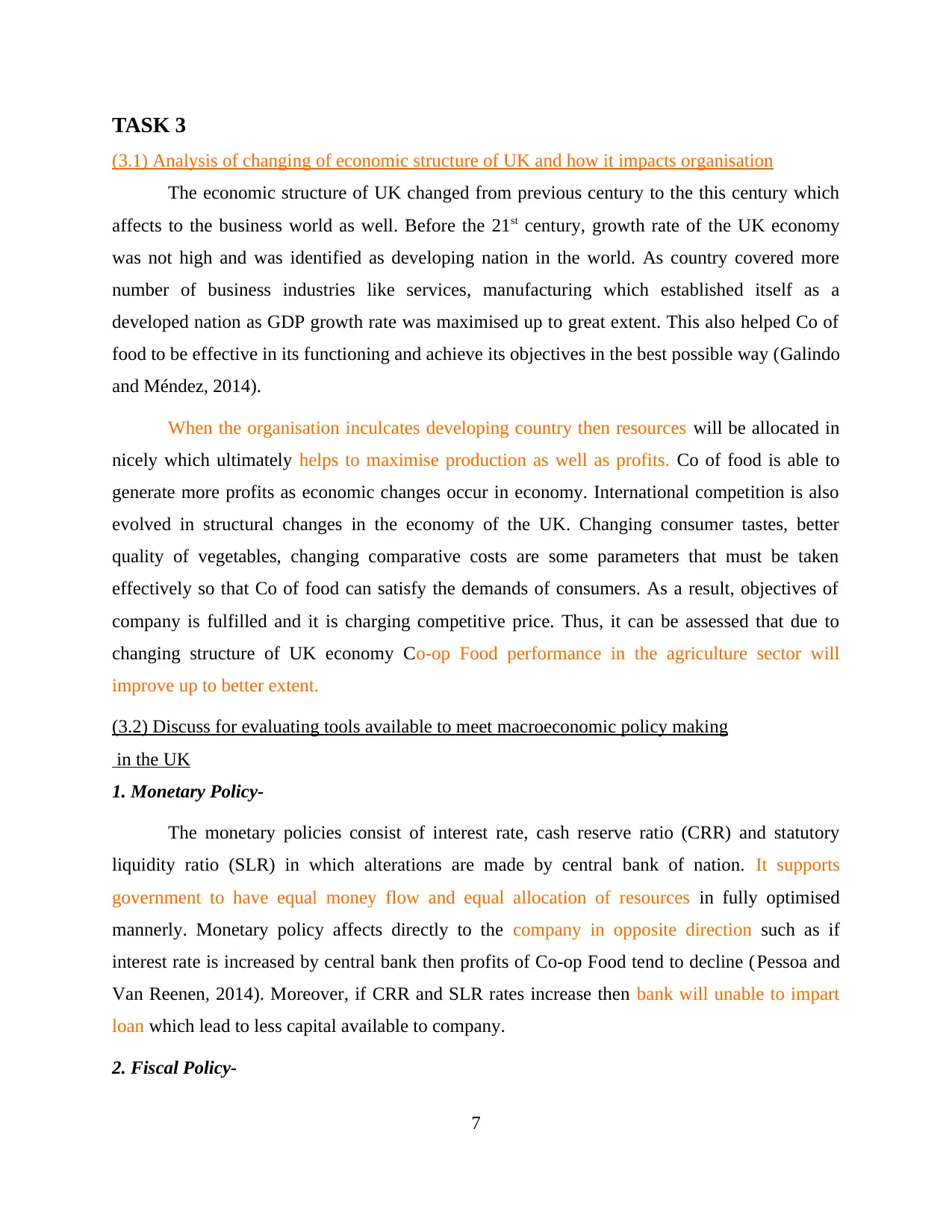
TASK 3
(3.1) Analysis of changing of economic structure of UK and how it impacts organisation
The economic structure of UK changed from previous century to the this century which
affects to the business world as well. Before the 21st century, growth rate of the UK economy
was not high and was identified as developing nation in the world. As country covered more
number of business industries like services, manufacturing which established itself as a
developed nation as GDP growth rate was maximised up to great extent. This also helped Co of
food to be effective in its functioning and achieve its objectives in the best possible way (Galindo
and Méndez, 2014).
When the organisation inculcates developing country then resources will be allocated in
nicely which ultimately helps to maximise production as well as profits. Co of food is able to
generate more profits as economic changes occur in economy. International competition is also
evolved in structural changes in the economy of the UK. Changing consumer tastes, better
quality of vegetables, changing comparative costs are some parameters that must be taken
effectively so that Co of food can satisfy the demands of consumers. As a result, objectives of
company is fulfilled and it is charging competitive price. Thus, it can be assessed that due to
changing structure of UK economy Co-op Food performance in the agriculture sector will
improve up to better extent.
(3.2) Discuss for evaluating tools available to meet macroeconomic policy making
in the UK
1. Monetary Policy-
The monetary policies consist of interest rate, cash reserve ratio (CRR) and statutory
liquidity ratio (SLR) in which alterations are made by central bank of nation. It supports
government to have equal money flow and equal allocation of resources in fully optimised
mannerly. Monetary policy affects directly to the company in opposite direction such as if
interest rate is increased by central bank then profits of Co-op Food tend to decline (Pessoa and
Van Reenen, 2014). Moreover, if CRR and SLR rates increase then bank will unable to impart
loan which lead to less capital available to company.
2. Fiscal Policy-
7
(3.1) Analysis of changing of economic structure of UK and how it impacts organisation
The economic structure of UK changed from previous century to the this century which
affects to the business world as well. Before the 21st century, growth rate of the UK economy
was not high and was identified as developing nation in the world. As country covered more
number of business industries like services, manufacturing which established itself as a
developed nation as GDP growth rate was maximised up to great extent. This also helped Co of
food to be effective in its functioning and achieve its objectives in the best possible way (Galindo
and Méndez, 2014).
When the organisation inculcates developing country then resources will be allocated in
nicely which ultimately helps to maximise production as well as profits. Co of food is able to
generate more profits as economic changes occur in economy. International competition is also
evolved in structural changes in the economy of the UK. Changing consumer tastes, better
quality of vegetables, changing comparative costs are some parameters that must be taken
effectively so that Co of food can satisfy the demands of consumers. As a result, objectives of
company is fulfilled and it is charging competitive price. Thus, it can be assessed that due to
changing structure of UK economy Co-op Food performance in the agriculture sector will
improve up to better extent.
(3.2) Discuss for evaluating tools available to meet macroeconomic policy making
in the UK
1. Monetary Policy-
The monetary policies consist of interest rate, cash reserve ratio (CRR) and statutory
liquidity ratio (SLR) in which alterations are made by central bank of nation. It supports
government to have equal money flow and equal allocation of resources in fully optimised
mannerly. Monetary policy affects directly to the company in opposite direction such as if
interest rate is increased by central bank then profits of Co-op Food tend to decline (Pessoa and
Van Reenen, 2014). Moreover, if CRR and SLR rates increase then bank will unable to impart
loan which lead to less capital available to company.
2. Fiscal Policy-
7
⊘ This is a preview!⊘
Do you want full access?
Subscribe today to unlock all pages.

Trusted by 1+ million students worldwide
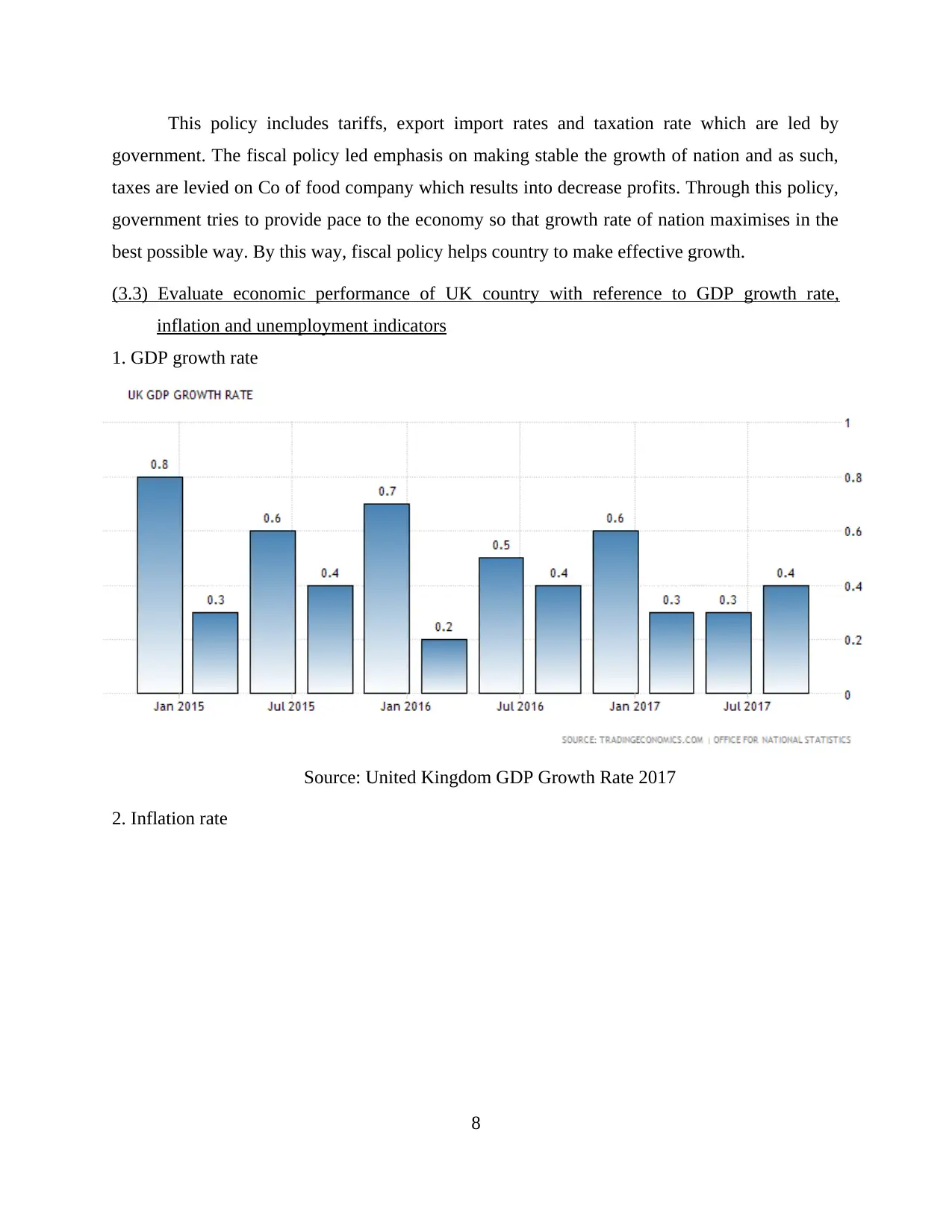
This policy includes tariffs, export import rates and taxation rate which are led by
government. The fiscal policy led emphasis on making stable the growth of nation and as such,
taxes are levied on Co of food company which results into decrease profits. Through this policy,
government tries to provide pace to the economy so that growth rate of nation maximises in the
best possible way. By this way, fiscal policy helps country to make effective growth.
(3.3) Evaluate economic performance of UK country with reference to GDP growth rate,
inflation and unemployment indicators
1. GDP growth rate
2. Inflation rate
8
Source: United Kingdom GDP Growth Rate 2017
government. The fiscal policy led emphasis on making stable the growth of nation and as such,
taxes are levied on Co of food company which results into decrease profits. Through this policy,
government tries to provide pace to the economy so that growth rate of nation maximises in the
best possible way. By this way, fiscal policy helps country to make effective growth.
(3.3) Evaluate economic performance of UK country with reference to GDP growth rate,
inflation and unemployment indicators
1. GDP growth rate
2. Inflation rate
8
Source: United Kingdom GDP Growth Rate 2017
Paraphrase This Document
Need a fresh take? Get an instant paraphrase of this document with our AI Paraphraser
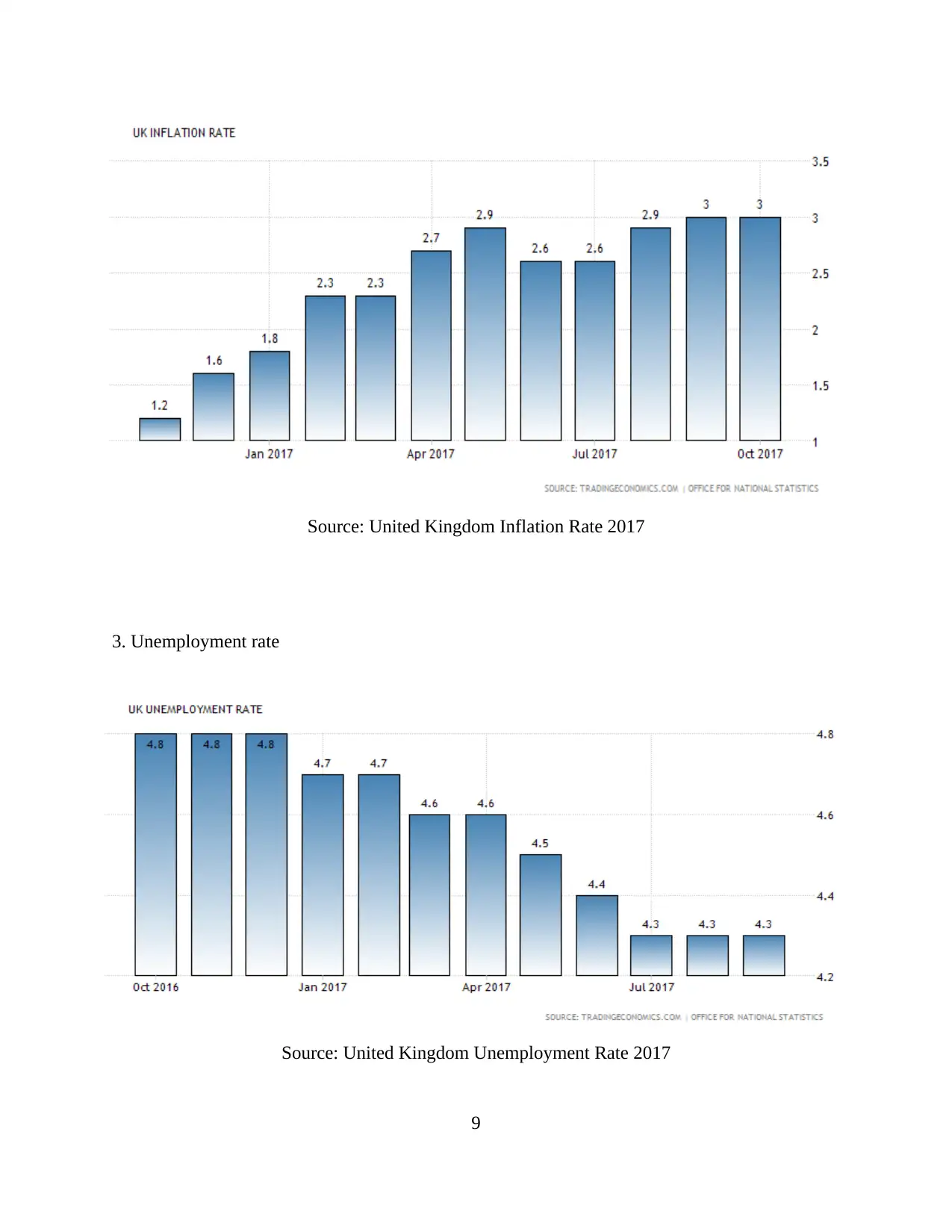
3. Unemployment rate
9
Source: United Kingdom Inflation Rate 2017
Source: United Kingdom Unemployment Rate 2017
9
Source: United Kingdom Inflation Rate 2017
Source: United Kingdom Unemployment Rate 2017
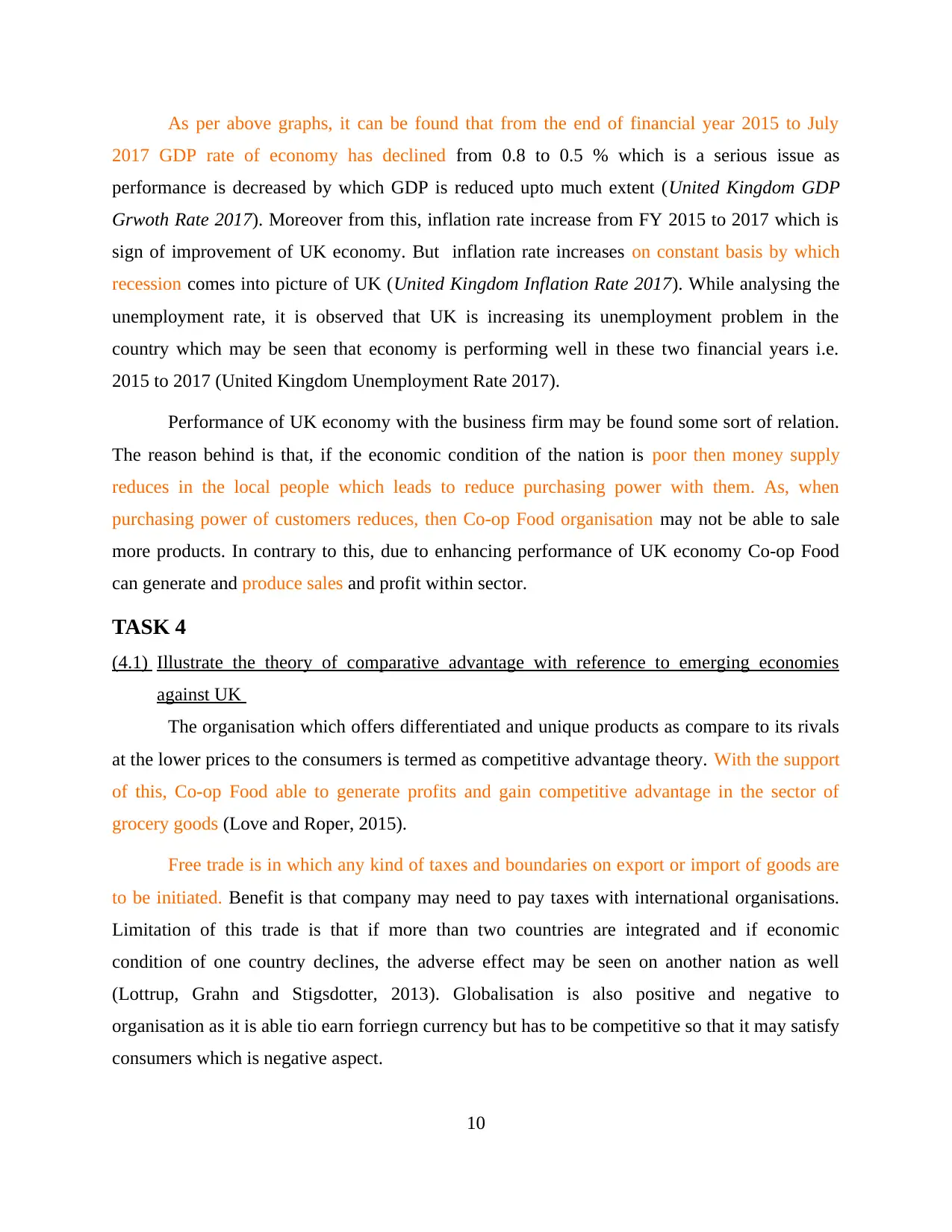
As per above graphs, it can be found that from the end of financial year 2015 to July
2017 GDP rate of economy has declined from 0.8 to 0.5 % which is a serious issue as
performance is decreased by which GDP is reduced upto much extent (United Kingdom GDP
Grwoth Rate 2017). Moreover from this, inflation rate increase from FY 2015 to 2017 which is
sign of improvement of UK economy. But inflation rate increases on constant basis by which
recession comes into picture of UK (United Kingdom Inflation Rate 2017). While analysing the
unemployment rate, it is observed that UK is increasing its unemployment problem in the
country which may be seen that economy is performing well in these two financial years i.e.
2015 to 2017 (United Kingdom Unemployment Rate 2017).
Performance of UK economy with the business firm may be found some sort of relation.
The reason behind is that, if the economic condition of the nation is poor then money supply
reduces in the local people which leads to reduce purchasing power with them. As, when
purchasing power of customers reduces, then Co-op Food organisation may not be able to sale
more products. In contrary to this, due to enhancing performance of UK economy Co-op Food
can generate and produce sales and profit within sector.
TASK 4
(4.1) Illustrate the theory of comparative advantage with reference to emerging economies
against UK
The organisation which offers differentiated and unique products as compare to its rivals
at the lower prices to the consumers is termed as competitive advantage theory. With the support
of this, Co-op Food able to generate profits and gain competitive advantage in the sector of
grocery goods (Love and Roper, 2015).
Free trade is in which any kind of taxes and boundaries on export or import of goods are
to be initiated. Benefit is that company may need to pay taxes with international organisations.
Limitation of this trade is that if more than two countries are integrated and if economic
condition of one country declines, the adverse effect may be seen on another nation as well
(Lottrup, Grahn and Stigsdotter, 2013). Globalisation is also positive and negative to
organisation as it is able tio earn forriegn currency but has to be competitive so that it may satisfy
consumers which is negative aspect.
10
2017 GDP rate of economy has declined from 0.8 to 0.5 % which is a serious issue as
performance is decreased by which GDP is reduced upto much extent (United Kingdom GDP
Grwoth Rate 2017). Moreover from this, inflation rate increase from FY 2015 to 2017 which is
sign of improvement of UK economy. But inflation rate increases on constant basis by which
recession comes into picture of UK (United Kingdom Inflation Rate 2017). While analysing the
unemployment rate, it is observed that UK is increasing its unemployment problem in the
country which may be seen that economy is performing well in these two financial years i.e.
2015 to 2017 (United Kingdom Unemployment Rate 2017).
Performance of UK economy with the business firm may be found some sort of relation.
The reason behind is that, if the economic condition of the nation is poor then money supply
reduces in the local people which leads to reduce purchasing power with them. As, when
purchasing power of customers reduces, then Co-op Food organisation may not be able to sale
more products. In contrary to this, due to enhancing performance of UK economy Co-op Food
can generate and produce sales and profit within sector.
TASK 4
(4.1) Illustrate the theory of comparative advantage with reference to emerging economies
against UK
The organisation which offers differentiated and unique products as compare to its rivals
at the lower prices to the consumers is termed as competitive advantage theory. With the support
of this, Co-op Food able to generate profits and gain competitive advantage in the sector of
grocery goods (Love and Roper, 2015).
Free trade is in which any kind of taxes and boundaries on export or import of goods are
to be initiated. Benefit is that company may need to pay taxes with international organisations.
Limitation of this trade is that if more than two countries are integrated and if economic
condition of one country declines, the adverse effect may be seen on another nation as well
(Lottrup, Grahn and Stigsdotter, 2013). Globalisation is also positive and negative to
organisation as it is able tio earn forriegn currency but has to be competitive so that it may satisfy
consumers which is negative aspect.
10
⊘ This is a preview!⊘
Do you want full access?
Subscribe today to unlock all pages.

Trusted by 1+ million students worldwide
1 out of 15
Related Documents
Your All-in-One AI-Powered Toolkit for Academic Success.
+13062052269
info@desklib.com
Available 24*7 on WhatsApp / Email
![[object Object]](/_next/static/media/star-bottom.7253800d.svg)
Unlock your academic potential
Copyright © 2020–2025 A2Z Services. All Rights Reserved. Developed and managed by ZUCOL.





